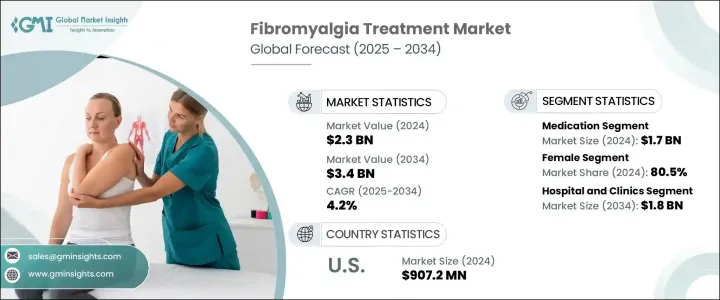
세계의 섬유근육통 치료 시장은 2024년 23억 달러로 평가되었고 신경화학적 불균형과 중추성 감작을 포함한 섬유근육통의 복잡한 병태생리에 대한 이해가 깊어짐에 따라 4.2%의 연평균 복합 성장률(CAGR)로 성장해 2034년까지 34억 달러에 달할 것으로 추정되고 있습니다.
정량적 감각 검사 및 만성 통증 증후군의 바이오마커 개발과 같은 진단 방법의 발전으로 조기적이고 정확한 진단이 향상되고 있습니다.

게다가 인공지능(AI)을 탑재한 플랫폼이나 디지털 헬스 기술을 도입함으로써 증상 추적과 관리가 강화되어 보다 맞춤 치료 접근이 가능해졌습니다. 제약기업, 학술기관, 임상의에 의한 업계를 넘은 협력체제가 선진적인 치료제의 개발에 박차를 가해 치료방법과 치료결과의 방향성을 바꾸고 있습니다. 이 시장에는 만성 통증, 피로, 섬유근육통의 관련 증상의 관리를 목적으로 진통제 및 항우울제와 같은 약물 요법 및 대체 요법을 포함한 약물 요법과 비 약물 요법이 포함됩니다.
| 시장 범위 | |
|---|---|
| 시작 연도 | 2024년 |
| 예측 기간 | 2025-2034년 |
| 당초 시장 규모 | 23억 달러 |
| 시장 규모 예측 | 34억 달러 |
| CAGR | 4.2% |
통증, 피로, 그 후의 증상 관리에 대한 환자의 기대가 높아짐에 따라 약물요법 부문은 2024년에 17억 달러를 창출했습니다. 주요 약제 클래스에는 항우울제, 항경련제, 진통제 등이 있으며, 환자의 QOL 향상에 공헌하고 있습니다. 이 부문의 성장을 지지하고 있는 것은 신약이나 그 개량품의 발매이며, 섬유근육통에 특화해 FDA에 승인된 최초의 약의 하나인 프레가발린 등, 기존약의 판매 승인의 확대이기도 합니다.
남녀별로 섬유근육통 치료 시장은 남성과 여성으로 나뉘어집니다. 여성 부문은 2024년 80.5%의 큰 시장 점유율을 차지했습니다. 미국 국립 생물공학 정보센터(NCBI)가 보고한 바와 같이, 섬유근통 증후군은 여성 우위성이 높고, 증례의 80%-96%를 차지하고 있습니다. 이 차이는 호르몬의 요인, 통증의 느낌의 차이, 신경계의 기능의 차이 등에 근거해 설명되고 있습니다.
미국의 섬유근육통 시장은 질 높은 건강 관리 시스템, 높은 질병 유병률, 광범위의 제약산업으로 인해, 2024년 9억 720만 달러로 평가되었습니다. 새로운 동향으로는 진단을 위한 원격 의료나 보다 개별화된 의료로의 시프트를 들 수 있습니다.
세계의 섬유근육통 치료 업계에서 사업을 전개하는 주요 기업으로는 Abbott Laboratories, AbbVie, Amneal Pharmaceuticals, AstraZeneca, Colorado Fibromyalgia Center, Eli Lilly and Company, Lupin, Mayo Clinic, Novartis, Pfizer, Sun Pharmaceutical, Teva Pharmaceutical, The General Hospital Corporation, UT Health Austin, Viatris, Zydus Lifesciences. 등이 있습니다. 치료 효과를 높이기 위한 제제화, 투여 요법 최적화, 약물전달 기술의 향상 등이 포함됩니다. 또, 많은 대기업은 학술 기관이나 연구 기관과 전략적 제휴를 맺어 차세대 치료의 발견과 상업화를 가속시키고 있습니다.
The Global Fibromyalgia Treatment Market was valued at USD 2.3 billion in 2024 and is estimated to grow at a CAGR of 4.2% to reach USD 3.4 billion by 2034, driven by a deeper understanding of fibromyalgia's complex pathophysiology, including neurochemical imbalances and central sensitization. Advances in diagnostic methods, such as quantitative sensory testing and the development of biomarkers for chronic pain syndromes, have improved early and accurate diagnosis. Integrating technology, including functional MRI and proteomic analysis, helps in identifying specific pain pathways and tailoring treatment strategies, thereby boosting market growth.

Additionally, incorporating artificial intelligence (AI)-powered platforms and digital health technologies has enhanced symptom tracking and management, enabling more personalized care approaches. The shift towards non-invasive treatments, such as neuromodulation and biofeedback, indicates a growing acceptance of holistic frameworks. Cross-industry collaboration among pharmaceutical companies, academic institutions, and clinical practitioners has catalyzed the development of advanced therapeutics, changing the course of treatment approaches and outcomes. The market encompasses pharmaceutical and non-pharmacological treatments aimed at managing chronic pain, fatigue, and associated symptoms of fibromyalgia, including medications like analgesics and antidepressants, as well as alternative therapies.
| Market Scope | |
|---|---|
| Start Year | 2024 |
| Forecast Year | 2025-2034 |
| Start Value | $2.3 Billion |
| Forecast Value | $3.4 Billion |
| CAGR | 4.2% |
The medication segment generated USD 1.7 billion in 2024 due to increased patient expectations regarding pain, fatigue, and subsequent symptom management. Demand is rising for pharmacological approaches, which explains why the medication segment dominates the market. Key drug classes include antidepressants, anticonvulsants, and analgesic drugs that help patients enjoy a better quality of life. The growth in this segment is supported by the launch of new drugs and their reformulations, along with increased marketing authorizations of existing ones, such as pregabalin, one of the first FDA-approved drugs specifically for fibromyalgia.
Based on gender, the fibromyalgia treatment market is divided into male and female segments. The female segment accounted for a significant market share of 80.5% in 2024. The female segment represents a market share, as the condition disproportionately affects women. As reported by the National Center for Biotechnology Information (NCBI), fibromyalgia syndrome has a high female predominance, comprising 80%-96% of cases. These differences have been explained based on hormonal factors, greater pain perception, and variations in the functions of the nervous system.
U.S. Fibromyalgia Treatment Market was valued at USD 907.2 million in 2024 due to its quality healthcare system, high disease prevalence, and extensive pharmaceutical industry. FDA-approved drugs such as duloxetine, milnacipran, and pregabalin dominate the prescription landscape. Patients are further motivated to seek treatment due to awareness programs and insurance coverage. Emerging trends include telemedicine for diagnosis and a shift toward a more personalized approach to medicine. Clinical research for new therapy approaches includes non-pharmaceutical options such as cognitive behavioral therapy and lifestyle changes.
Major players operating in the Global Fibromyalgia Treatment Industry include Abbott Laboratories, AbbVie, Amneal Pharmaceuticals, AstraZeneca, Colorado Fibromyalgia Center, Eli Lilly and Company, Lupin, Mayo Clinic, Novartis, Pfizer, Sun Pharmaceutical, Teva Pharmaceutical, The General Hospital Corporation, UT Health Austin, Viatris, and Zydus Lifesciences. To strengthen their market foothold, companies in the fibromyalgia treatment sector are emphasizing innovation through robust investments in research and development. This includes advancing drug formulations, optimizing dosage regimens, and improving delivery technologies to increase patient adherence and therapeutic effectiveness. Many leading firms are also forming strategic alliances with academic institutions and research organizations to accelerate the discovery and commercialization of next-generation treatments.